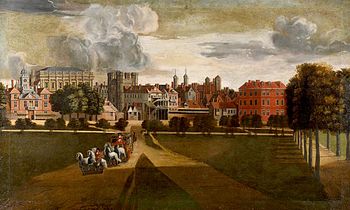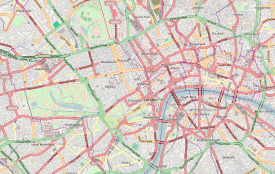Whitehall Palace
| Palace of Whitehall | |
|---|---|

The Palace of Whitehall by Hendrick Danckerts, c. 1675. The view is from the west, in St. James's Park. The Horse Guards barracks are on the extreme left, with the taller Banqueting House behind it. The four-towered building left of centre is the palace gatehouse, the "Holbein Gate".
|
|
| Location | City of Westminster, London, England, United Kingdom |
| Coordinates | 51°30′16″N 00°07′32″W / 51.50444°N 0.12556°WCoordinates: 51°30′16″N 00°07′32″W / 51.50444°N 0.12556°W |
| Built | c. 1240, 15-17th cent. |
| Demolished | 1698 (due to fire) |
The Palace of Whitehall (or Palace of White Hall) was the main residence of the English monarchs in London from 1530 until 1698 when most of its structures, except for Inigo Jones's 1622 Banqueting House, were destroyed by fire. Before then, it had grown to be the largest palace in Europe with more than 1,500 rooms, overtaking the Vatican and Versailles. The palace gives its name, Whitehall, to the road on which many of the current administrative buildings of the UK government are situated, and hence metonymically to the central government itself.
At its most expansive, the palace extended over much of the area bordered by Northumberland Avenue in the north; to Downing Street and nearly to Derby Gate in the south; and from roughly the elevations of the current buildings facing Horse Guards Road in the west, to the then banks of the River Thames in the east (the construction of Victoria Embankment has since reclaimed more land from the Thames)—a total of about 23 acres (93,000 m2). It is about 650 metres from Westminster Abbey.
By the 13th century the Palace of Westminster had become the centre of government in England, and had been the main London residence of the king since 1049. The surrounding area became a popular and expensive location. The Archbishop of York Walter de Grey bought a nearby property as his London residence soon after 1240, calling it York Place.
...
Wikipedia

